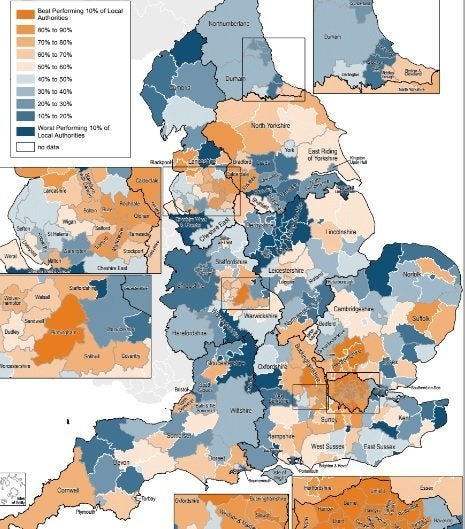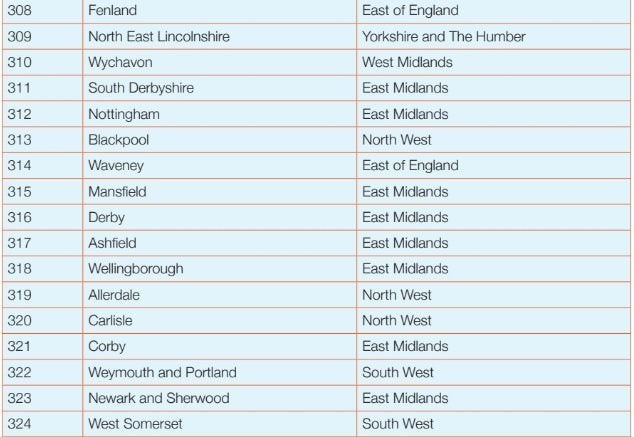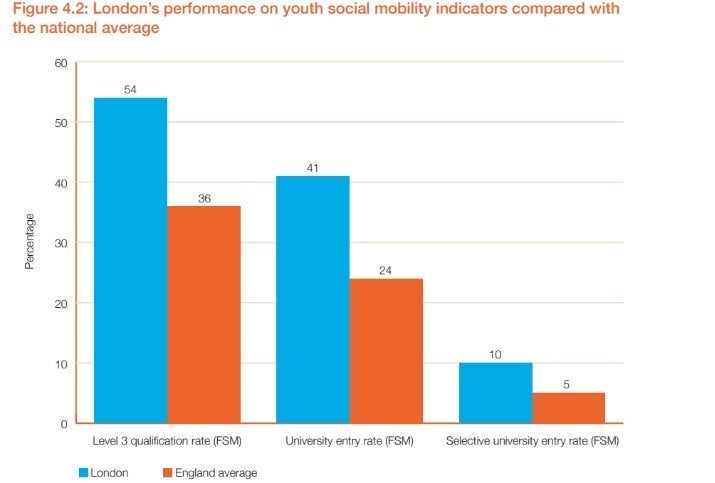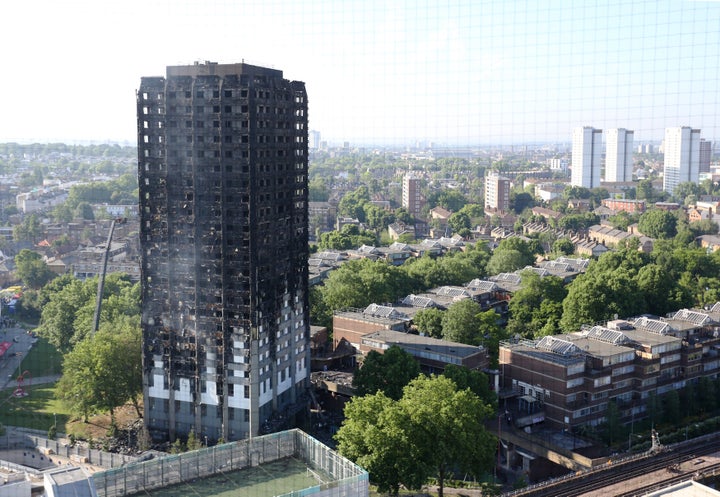
Britain’s small towns have the lowest social mobility of anywhere in the UK, a new ‘league table’ has revealed.
The independent Social Mobility Commission’s (SMC) annual State of the Nation report found a stark “postcode lottery” determined the chances of poor children across the country succeeding in life.
The study lays bare a startling geographical divide, with London and its surrounding areas pulling away from the rest of the country, while many other areas suffering both economically and socially.
The SMC, led by former Labour Cabinet minister Alan Milburn, calls on the Government to increase the proportion of spending on those parts of the country that most need it, amid claims that the north is underfunded by £6 billion a year compared to London.
A critical factor in the performance of the best areas is the number and quality of teachers available.
London has gone from having the worst schools in England to having the best, thanks to links between schools and more fast-tracked teachers. In contrast, a secondary teacher in the most deprived areas is 70 per cent more likely to leave.

The annual report includes a Social Mobility Index, which ranks all 324 local authorities in England in terms of their social mobility prospects for someone from a disadvantaged background.
Using a range of 16 indicators, from early years through to working lives, it maps the nation’s social mobility best and worst areas.
Bottom of the league of 324 areas are West Somerset, Newark in Nottinghamshire, Corby in the East Midlands and Carlisle in the North West of England. Derby, Ashfield, Blackpool and North East Lincolnshire also delivered poor outcomes for disadvantaged children.

Top of the league are London boroughs, from the wealthy Westminster and Kensington and Chelsea to poorer Tower Hamlets and Hackney and Islington.
In each of them, the capital’s high quality schooling has made a huge difference in the ability of children on free school meals to get the grades needed to get into university and well-paid jobs.

The research found that London is improving its social mobility, while rural, coastal and former industrial areas are getting worse.
The study follows a new Centre for Towns think tank report earlier this month that showed a huge generational shift from small towns to cities. Towns have lost nearly a million young people, while gaining more pensioners than elsewhere.
The new State of the Nation report, published on Tuesday, debunks the idea of a simple north-south divide or a rich-poor divide on life chances for the most disadvantaged.
The index found that the worst-performing areas for social mobility were no longer inner city areas and instead remote rural or coastal areas and former industrial areas, especially in the Midlands.

Youngsters from disadvantaged backgrounds who live there face far higher barriers than those who grow up in cities and their surrounding areas.
Some 51 per cent of London children on free school meals achieve A* to C in English and maths GCSE, compared to an average of 36 per cent in all other English regions. In Westminster, 63 per cent get good English and maths GCSEs, but in the Isle of Wight only 27 per cent do.
Kensington and Chelsea, which has been heavily criticised for its response to the Grenfell Tower disaster, comes second in the league table, mainly because every child on free school meals in the borough attends a good or outstanding school.
Together with its high rates of skilled work, the educational impact offsets its “very poor performance on our housing indicators”, the Commission concluded.
Some 50 per cent of disadvantaged youngsters in Kensington and Chelsea make it to university, but in Hastings, Barnsley and Eastbourne, the university participation rate for this group falls to just 10 per cent

In their working lives, people in small towns face lower rates of pay, fewer top jobs and travel-to-work times nearly four times those of other urban residents.
While richer areas tend to outperform deprived areas in the Index, a number of places buck the trend. Some of the most deprived areas in England - including most London boroughs like Tower Hamlets, Hackney and Newham - have impressive social mobility indices for education.
In contrast, some wealthy areas – such as West Berkshire, Cotswold and Crawley - are amongst the worst for offering good education, employment opportunities and affordable housing to their most disadvantaged residents.

Milburn said: “The country seems to be in the grip of a self-reinforcing spiral of ever-growing division. There is a stark social mobility lottery in Britain today.
“London and its hinterland are increasingly looking like a different country from the rest of Britain. It is moving ahead, as are many of our country’s great cities. But too many rural and coastal areas and the towns of Britain’s old industrial heartlands are being left behind economically and hollowed out socially.
“Tinkering around the edges will not do the trick. A less divided Britain will require a more redistributive approach to spreading education, employment and housing prospects across our country.”
Among the report’s key recommendations are:
* Every local authority should develop an integrated strategy for improving disadvantaged children’s outcomes, with Pupil Premium funds invested in evidence-based practice.
* Councils should support collaboration between isolated schools, subsidise transport for disadvantaged young people in isolated areas and encourage Local Enterprise Partnerships (LEP) to boost careers support.
* Councils should all become accredited Living Wage employers and encourage others in their communities to do likewise, like Islington in London.
* Central government should launch a fund to enable schools in rural and coastal areas to partner with other schools to boost attainment
* Regional School Commissioners should be given responsibility to work with universities, schools and Teach First to ensure that there is a good supply of teachers in all parts of their regions.
* Central government should rebalance the national transport budget to deliver a more equal share of investment per person and contribute towards a more regionally balanced economy.
The Government preferred to point to the educational success stories in the report.
Education Secretary Justine Greening said the findings underlined “the importance of focusing our efforts in more disadvantaged areas where we can make the biggest difference”.
“We are making progress. There are now 1.8 million more children in good or outstanding schools than in 2010. Disadvantaged young people are entering universities at record rates and the attainment gap between them and their peers has narrowed,” she said.
“We are also boosting salaries through the introduction of the National Living Wage, creating more full-time, permanent jobs and investing £9bn in affordable housing. Taken together, this won’t just change individual lives, it will help transform our country into a fairer society.”
